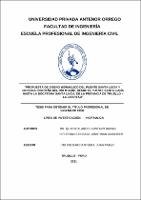Propuesta de diseño hidráulico del puente Santa Lucia y defensa ribereña del río moche, desde el puente Santa Lucia hasta la bocatoma Santa Lucía, de la provincia de Trujillo - La libertad

View/
Download
(application/pdf: 5.094Mb)
(application/pdf: 5.094Mb)
Date
2021Author(s)
Quiroz Alarco, Gustavo Rafael
Robles Rebaza, Cristhian Gianpieer
Metadata
Show full item recordAbstract
La presente tesis tiene como objetivo el diseño hidráulico del puente Santa Lucia y
mejorar la defensa ribereña del Rio Moche, desde el puente Santa Lucia, hasta la
bocatoma Santa Lucia, corresponde a la especialidad de Hidráulica fluvial, donde
se han analizado y calculado aspectos importantes del cauce y flujo del río Moche,
además se ha realizado el modelo unidimensional un Puente que propondremos
que cruzará el río moche en el sector Santa Lucia.
Para los cálculos se han utilizado teorías de la hidráulica fluvial y metodologías para
el tipo de cauce de rio, es decir morfología y distribución granulométrica de los
sedimentos de fondo.
Los datos utilizados han sido principalmente los obtenidos por levantamiento
topográfico con con GPS diferencial y drone (Ortofotos y Dem), datos hidrológicos
(caudales) y datos de sedimentos de fondo. Las herramientas utilizadas han sido
los softwares Excel, Civil 3D, Hec Ras y ArcGis.
Asimismo, se ha realizado el modelamiento numérico unidimensional con el
software Hec Ras (programa libre) para evaluar el comportamiento del río frente a
las estructuras planteadas.
Donde el modelo unidimensional nos muestra que las velocidades máximas se
encuentran en las secciones que se encuentran pegadas al puente siendo estas de
4.55m3/s, 5.25m3/s y 6.60 m3/s para periodos de retorno de 50, 100 y 500 años
respectivamente, lo cual estas velocidades producirán gran erosión en los pilares
del puente.
Dichas velocidades producidas por los caudales que pasan por el rio Moche a la
altura del puente Santa Lucia afectan directamente a los pilares puesto que entre
los pilares se generan las velocidades máximas causando daño a estos, lo cual en
mediano plazo se encontraran en estado de deterioro y produciendo socavación
local de hasta 10.00 m en esta zona de los pilares. The objective of this thesis is the hydraulic design of the Santa Lucia bridge and
improve the riverside defense of the Moche River, from the Santa Lucia bridge, to
the Santa Lucia intake, it corresponds to the specialty of Fluvial Hydraulics, where
important aspects have been analyzed and calculated of the riverbed and flow of
the Moche River, in addition, a one-dimensional model has been made, a Bridge
that we will propose that will cross the Moche River in the Santa Lucia sector.
For the calculations, theories of fluvial hydraulics and methodologies for the type of
riverbed have been used, that is, morphology and granulometric distribution of the
bottom sediments.
Likewise, one-dimensional numerical modeling has been carried out with the Hec
Ras software (free program) to evaluate the behavior of the river against the
proposed structures.
The data used have been mainly those obtained by topographic survey with
differential GPS and drone (Orthophotos and Dem), hydrological data (flows) and
bottom sediment data. The tools used have been the Excel, Civil 3D, Hec Ras and
ArcGis softwares.
Where the one-dimensional model shows us that the maximum speeds are found
in the sections that are attached to the bridge, being 4.55m3 / s, 5.25m3 / s and
6.60 m3 / s for return periods of 50, 100 and 500 years respectively, which these
speeds will produce great erosion in the piers of the bridge.
These speeds produced by the flows that pass through the Moche river at the
height of the Santa Lucia bridge directly affect the pillars since the maximum
speeds are generated between the pillars causing damage to them, which in the
medium term will be in a state of deterioration and producing local scour of up to
10.00 m in this area of the pillars
Subject
Collections
- Ingeniería Civil [1260]

